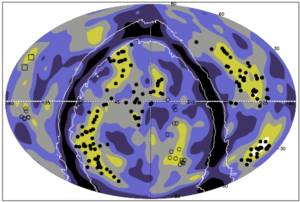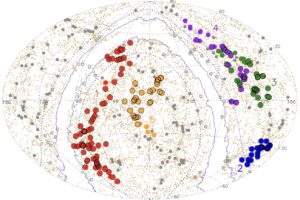
Galaxy Structure distribution in density gradients. White, Olive & Gray are the Densest volumes – Black & Blue the least dense volumes. The density ratio to the average density is shown by six contour levels: 0 – 0.23 (black), 0.23 – 0.62 (dark blue), 0.62 – 1.13 (light blue), 1.13 – 1.9 (grey), 1.9 – 3.7 (olive), and > 3.7 (white). The clusters of the five superstructures are overplotted with filled black circles. Image Credit: Bohringer et al. 2025.
News: Feb 7, 2025: A newly identified structure in our Universe is immensely larger than all previously identified galaxy Sheets, Filaments or Voids. (1)
It is more than 1.3 Billion light years long; so large it encompasses some 13 percent of our observed Universe.
The discoverers named it Quipu after after an ancient South American communication system used primarily by Incas.

Universe’s Largest Newly Discovered Superstructures.
Quipu in red is the largest structure ever found in the Universe. The others include Shapley in blue, Serpens-Corona Borealis in green, Hercules in purple and Sculptor-Pegasus in vanilla.
Image Credit: Bohringer et al. 2025.
Commentary: Of course this coherent structure is massively too large to explain assembling in a mere 14 billion years.
It is just one more earthquake in the recent avalanche of unsolveable problems burying the few remaining Big Bang supporters.
Reference

